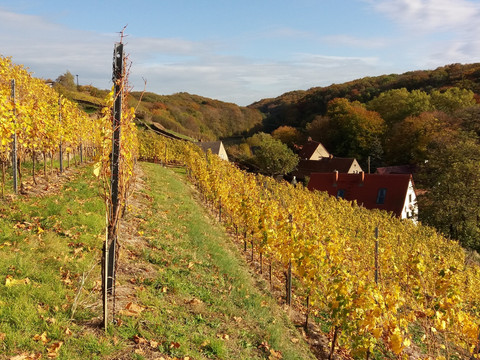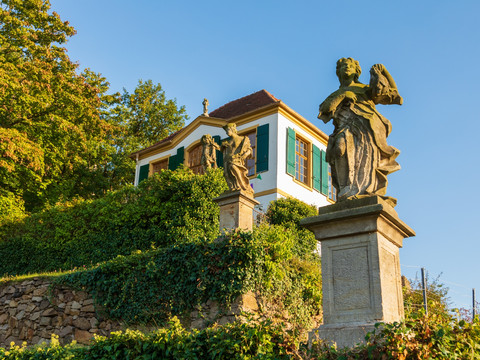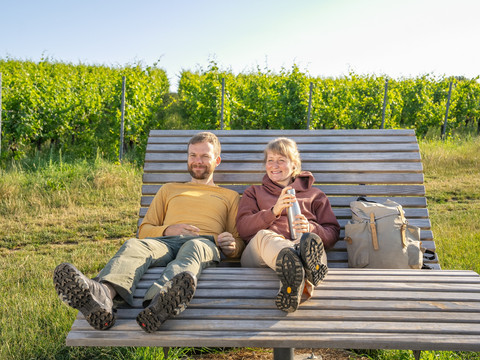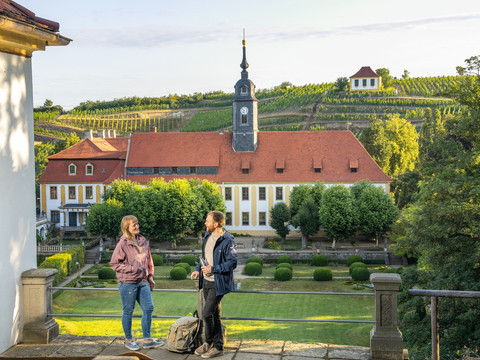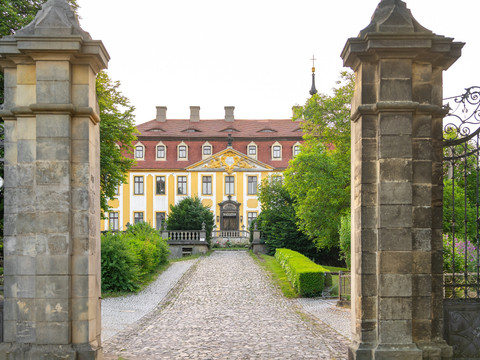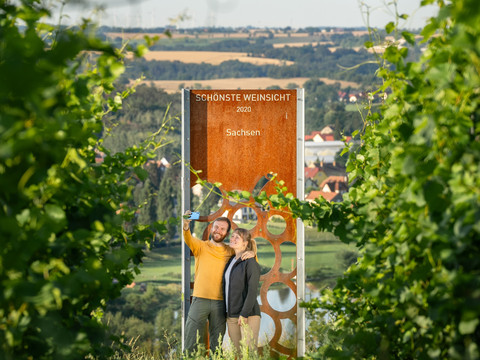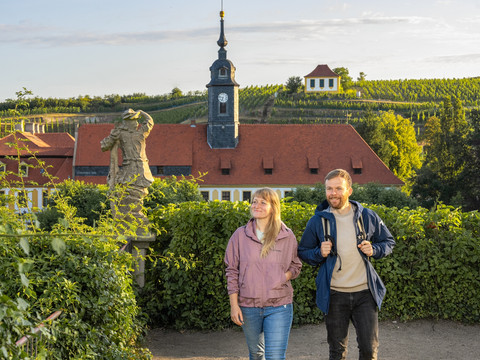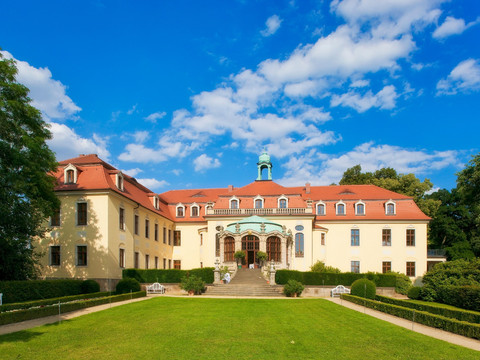From the station forecourt in Meißen, we cross Großenhainer Straße (crosswalk) and turn into Ludwig-Richter-Straße, walk uphill and then turn left into Ratsweinberg and circle the small vineyard in a clockwise direction. We come to Weinberggasse, into which we turn left, cross Zscheilaer Straße and follow Hafenstraße to Lindenplatz, from where we turn left to Fährgässchen and Dammweg (Elbe cycle path).
Down the Elbe, the route passes under the Elbe valley bridge, along the winter harbor to Hafenstraße, then briefly right and immediately left up the cat steps (stairs) to the vineyards, which are now managed by the Proschwitz Prinz zur Lippe Castle winery.
If you choose to take a detour to the left at the wrought-iron gate (vineyard cottage and stele "Schönste Weinsicht"), you will be rewarded with an excellent view of the Meissen Elbe valley from the Bennokanzel (approx. 20 min. walk).
After looking at the Albrechtsburg Castle in Meissen through the "Most beautiful wine view 2016" stele, we walk along Proschwitzer Straße through the village - past the renovated Proschwitz Castle with its beautiful and accessible park - until we reach a fork at the end of the village.
We turn left towards Winkwitz (Thomas-Müntzer-Str.). In Winkwitz, we follow the signposts, turn left into Schulstraße, then follow Winkwitzer Straße to the left and pass through orchards and vineyards, past a playground, to Rottewitz (both former villages now belong to the town of Meißen). Turning left into Rottewitzer Straße, we turn right at the end and walk down a small path into the ground.
We soon come to a heraldic gate that allows us to enter the vineyards (be sure to close the gate again due to game browsing). Keeping to the right, we then walk uphill on a farm track between vineyards to a wider farm track and then left to a vineyard gate. Now we turn right along an avenue of fruit trees towards Diera until we turn left at a crossroads onto the asphalt road (Eisenacher Straße) to Karpfenschänke (OT of Diera-Zehren). At the entrance to Karpfenschänke, we turn right off the road, following the signposts, and again pass through gates into the Lippe vineyards and finally, following the signposts, to Zadel with the church of St. Andreas, visible from afar, which is located along the way (Kirchstraße).
We enter the cemetery and walk past the church to the lower entrance to the cemetery, where we come to the Dorfanger road. Via Dorfanger, right into Schulstraße, left into Hohlweg - past the "Neumühle" district - and Zum Forsthaus we see the Golkwald vineyards on the left with the Winzerhof Golk (restaurant, guesthouse, wine shop).
Passing the "Talhaus Golk" (restaurant), we turn right from the road Zum Forsthaus after 200 m onto a small forest path. On the Kirch(en)Weg we come through the Golkwald forest to Löbsal with a fork in the village center (village square, Jägerheim restaurant). The right-hand path at the fork leads us towards Burgberg, an important archaeological site from the Bronze Age.
Via the former school path, we walk downhill through the forest to Diesbar, one of the wine villages which, with its traditional inns and steamboat traffic, has been a popular destination for people from Meissen and Dresden since the end of the 19th century. Many vineyards and old winegrowers' houses characterize the village, which is now also home to young wineries and modern restaurants. We take another look down the Elbe at the "Bösen Bruder", a granite quarry that was shut down in 1965, before we climb up the Am Brummochsenloch path to the right, past the Jan Ulrich winery.
On Radewitzer Straße, we reach the Goldkuppe (184 m), the largest Bronze Age rampart in Saxony (400 x 1100 m). Through an unlocked gate, we pass large vineyards and the "most beautiful wine view of 2020" with a view over the Elbe in Diesbar-Seußlitz. The path through the vineyards along a steeply sloping quarry edge offers us occasional beautiful views of the Elbe valley and the Göhrischfelsen rock on the other side of the Elbe. We pass through a gate and after a few meters through the forest we reach the viewing terrace of Heinrichsburg, a garden house built in 1728 by the then lord of the castle Heinrich von Bünau according to plans by George Bähr.
From here, we have an overwhelming view of Seußlitz Castle (not accessible) with its park (accessible), the adjacent George Bähr Church (open(open, worth seeing, as is the historic cemetery), Luisenburg Castle opposite (also built as a garden house), the Elbe ferry to Niederlommatzsch and Hirschstein Castle on the other side of the Elbe.
We walk down a few steps, past the sandstone figures by Permoser depicting the 12 months, and reach the forest road. We walk a short distance down the forest road. Now we can either turn right into the French park of Seußlitz Castle and take a look at the grounds. Or we can turn right onto the road An der Weinstraße and reach the 6th stage destination and the end of the Sußlitz Trail. This is the end of the Saxon Wine Trail (parking lot below the castle with access to the ferry to Niederlommatzsch, Seußlitz bus stop, castle/ferry with return option to Meißen, various information boards, restaurant, café and Haus des Gastes on the castle grounds).
Note: Parts of the trail lead along or through nature reserves. Leaving the paths at these points is not permitted in order to protect flora and fauna. Please follow the signs.

